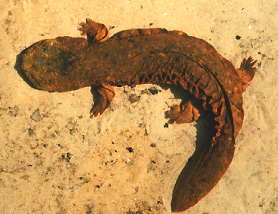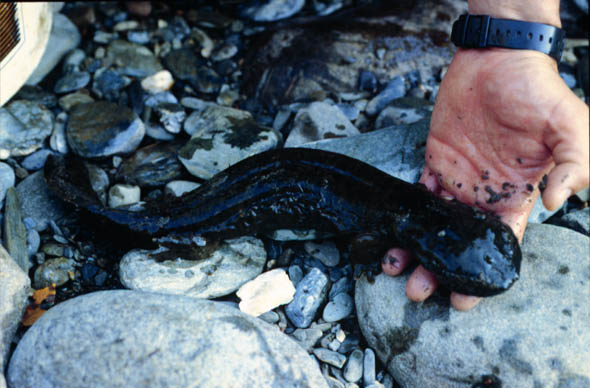
The eastern hellbender hails as America's largest aquatic salamander.
It is grey to olive brown.
The Eastern Hellbender is totally aquatic. They breath through
folds in their skin. The gills stay in their neck, but are not used.
The hellbender goes through incomplete metamorphis. The lungs are
used only for buoyancy. They can get up to 29 inches in size.
The young lose their gill slits at 4 or 5 inches. These external
gills make it very difficult for the salamander to survive anywhere but
in constantly flowing water.
Born with external gills and gill slits, a hellbender will not undergo the metamorphosis stage of losing its external gills for 18 months; this is one of the longest larval periods (that eventually produce a metamorphic change) of any American species of salamander.
Hellbenders can live to be 55 years old.
Food habits
The Eastern Hellbender is totally carnivorous. The diet consists
primarily of crayfish but insects, fish, and worms will also be eaten (Behler
and King 1979). The hellbender has a very unique mechanism for capturing
and consuming its prey. It exhibits a highly unusual mode of asymmetrical
suction feeding in which the bilateral elements of the mandibles and hyoid
move independently. Typically the hellbender only depresses one side of
the mandible, dropping the jaw 10 to 40 degrees from the resting position
and the prey is drawn in with a jet of water (Pough et al. 1998).
Aquatic salamanders such as the eastern hellbender have their ear bone attached to their lower jaw bone, and when they touch their lower jaw to the stream bottom vibrations are picked up and transmitted to the ear bone.
"the hellbender belongs to the suborder Cryptobranchoidea which is the most primitive of the living salamanders and may hold clues for scientists to use when studying the evolution of other salamanders" (Cogger and Zweifel 1998).
Hellbenders are aquatic organisms throughout their life and remain active year-round. These salamanders generally spend the daylight hours in a natural or self-excavated den beneath large slabs of rock or other shelter-providing objects (logs and boards) on the bottom of streams or rivers.
Acid Mine Drainage threat
Agricultural runoff and the acidic runoff from large scale mining
operations threaten much of
the hellbenders habitat. (Danch 1996).
It has disappeared from a large portion of its range due to silting
and pollution of streams.
The number of hellbenders has been reduced over the century because of acid mine drainage, industrial pollution, and excessive siltation.
The hellbender subsists primarily on crayfish, and no longer thrives in streams and rivers where pollution has destroyed crayfish populations.
Available evidence does suggest that numbers of these salamanders have declined and there is little evidence of successful reproduction recently.

Bibliography
Beffa, D.A. 1976. Responses of Cryptobranchus alleganiensis
alleganiensis to different oxygen
concentrations, temperature, and photoperiod. Unpublished
M.A. Thesis, Southwest Missouri University, Springfield, MO.
Bishop, S.C. 1941. The Salamanders of New York. New York State Museum Bulletin. No. 324, Albany, NY.
Blais, D.P. 1996. Movement, home range,
and other aspects of the biology of the eastern hellbender
(Cryptobranchus a. alleganiensis): A radio
telemetric study. Unpublished M.S. Thesis, State University of New
York at Binghamton, Binghamton, NY.
Coatney, C.E. 1982. Home range and nocturnal activity of the Ozark hellbender. M.S. Thesis, Southwest Missouri State University, 54 pp.
Dundee, H.A., and D.S. Dundee. 1965. Observations on the systematics and ecology of Cryptobranchus from the Ozark Plateaus of Missouri and Arkansas. Copeia. 3:369-370.
Fauth, J.E., B.W. Buchanan, S.E. Wise, S.M. Welter,
and M.J. Komoroski. 1996. Caudata:
Cryptobranchus alleganiensis alleganiensis (hellbender).
Coloration. Herpetological Review. 27(3) p. 135.
Gates, J.E., C.H. Hocutt, J.R. Stauffer, Jr., and G.J. Taylor. 1985. The distribution and status of Cryptobranchus alleganiensis in Maryland. Herpetol. Rev. 16:17-18.
Green, N. B. 1934. Cryptobranchus alleganiensis in West Virginia. Proceedings of the West Virginia Academy of Science. 17:28-30.
Green, N.B. and T.K. Pauley. 1987. Amphibians and Reptiles in West Virginia. University of Pittsburgh Press, Pittsburgh, PA. pp. 45-47.
Grote, A.R. 1877. A preliminary note on Menopoma alleghaniense of Harlan. American Association of Advances in Science Proceedings. 24:255-257.
Hillis, R.E., and E.D. Bellis. 1971. Some aspects of the ecology of the hellbender, Cryptobranchus alleganiensis, in a Pennsylvania stream. Journal of Herpetology. 5:121-126.
Holbrook, J. 1842. North American Herpetology.
2nd ed., Vol. 5. Philadelphia. vi. + 118 pp., 38 col. pl.
Ingersol, C.A. 1982. Seasonal reproductive
changes in Cryptobranchus alleganiensis. M.S. Thesis, Southwest
Missouri State Univ. 71 pp.
Humphries, W.J. 1999. Ecology and population demography of the hellbender, Cryptobranchus alleganiensis, in West Virginia. Unpublished M.S. Thesis. Marshall University, Huntington, WV.
McCoy, C.J. 1982. Amphibians and reptiles in Pennsylvania. Special Publications of the Carnegie Museum of Natural History. 6:1-91.
Netting, M.G. 1929. The food of the hellbender, Cryptobranchus alleganiensis (Daudin). Copeia. 170:23-24.
Nickerson, M.A., and C.E. Mays. 1973.
The Hellbenders: North America's "Giant Salamanders."
Publications in Biology and Geology, Milwaukee Public Museum.
1:1-106.
Nickerson, M.A. and C.E. Mays. 1973. A study of the Ozark hellbender Cryptobranchus alleganiensis bishopi. Ecology. 54:1164-1165.
Nigrelli, R.F. 1954. Some longevity records of vertebrates. Transactions of the New York Academy of Science. 16(6):296-299.
Noeske, T.A. and M.A. Nickerson. 1979. Diel activity rhythms in the hellbender, Cryptobranchus alleganiensis (Caudata: Cryptobranchidae). Copeia. 1:92-95.
Peterson, C.L., D.E. Metter, B.T. Metter, B.T. Miller,
R.F. Wilkinson, and M.S. Topping. 1988.
Demography of the hellbender, Cryptobranchus
alleganiensis, in the Ozarks. American Midland Naturalist.
119:291-303.
Peterson, C.L., and R.F. Wilkinson. 1996. Home range size of the hellbender (Cryptobranchus alleganiensis) in Missouri. Herpetological Review. 27(3):126-127.
Peterson, C.L., R.F. Wilkinson, Jr., M.S. Topping, and D.E. Metter. 1983. Age and growth of the Ozark hellbender (Cryptobranchus alleganiensis bishopi). Copeia. 225-231.
Petranka, J.W. 1998. Salamanders of the United States and Canada. Smithsonian Institution Press, Washington, D.C., pp. 140-144.
Prosen, E. 1999. Status of the eastern
hellbender (Cryptobranchus alleganiensis alleganiensis) in Missouri:
a comparison of past and present populations.
Unpublished M.S. Thesis. Southwest Missouri State Univ., Springfield, MO.
Reese, A.M. 1903. The habits of the giant salamander. Popular Science Monthly. 62:526-531.
Smith, P.W., and S.A. Minton, Jr. 1957. A distributional summary of the herpetofauna of Indiana and Illinois. The American Midland Naturalist. 58:341-351.
Taber, C.A., R.F. Wilkinson, Jr., and M.S. Topping. 1975. Age and Growth of hellbenders in the Niangua River, Missouri. Copeia. 4:633-638.
Trauth, S.E., J.D. Wilhide, and P. Daniel. 1992.
Status of the Ozark hellbender, Cryptobranchus bishopi
(Urodela: Cryptobranchidae), in the Spring River,
Fulton County, Arkansas. Proceedings of the Arkansas Academy of Science.
46:83-86.
Ultsch, G.R. and Duke, J.T. 1990. Gas exchange and habitat selection in the aquatic salamanders Necturus maculosus and Cryptobranchus alleganiensis. Oecologia. 83(2):250-258.
Williams, R.D., J.E. Gates, and C.H. Hocutt. 1981. An evaluation of known and potential sampling techniques for hellbender, Cryptobranchus alleganiensis. Journal of Herpetology. 15(1):23-27.